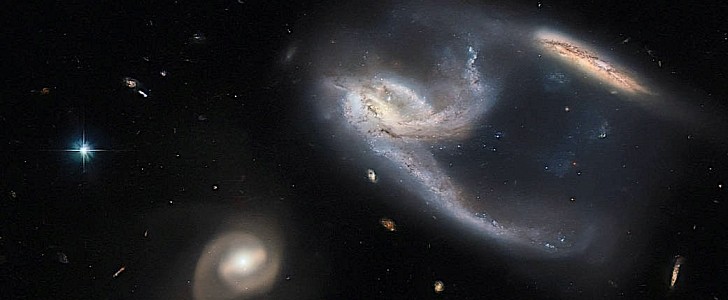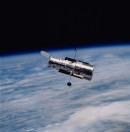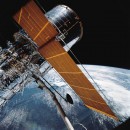
Photo: ESA/Hubble & NASA, J. Dalcanton, Dark Energy Survey, U.S. Department of Energy (DOE), Fermilab (FNAL), Dark Energy Survey Camera (DECam), Cerro Tololo Inter-American Observatory (CTIO), NoirLab/Nation
For the past month or so, the eyes of the world were affixed to the adventures of the James Webb Space Telescope (JWST), as it was heading for its very distant parking space from where it will look back into the past of the Universe. It will be a while until we get the first images (about half a year) though, so it’s no wonder the aging Hubble is back into the spotlight.
The veteran of space photography still has some juice in it, and from time to time it makes the headlines as NASA releases new images captured by what once was the star of the telescope industry. The most recent, shown at the end of last week, is the one we have here, showing a trio of galaxies called NGC 7764A.
That’s a bland name, perhaps just as bland as any of the three galaxies taken individually might be. But when seen from a certain angle, and in a certain way, the two at the right seem to combine into the shape of one of this Star Trek spaceship, with a central saucer sitting in front of two warp nacelles.
Hubble captured this image using the Advanced Camera for Surveys and Wide Field Camera 3 instruments, and NASA itself is so excited by it that says it “resembles the starship known as the USS Enterprise from Star Trek!”
The cluster of galaxies is located 425 million light-years from Earth, in a constellation known as Phoenix. It comprises individual galaxies NGC 7764A1, NGC 7764A2, and NGC 7764A3, and two of them look like they’re involved in something of a cosmic collision, probably not unlike what our own Milky Way will have to survive once Andromeda gets here 4.5 billion years from now.
And then, who knows, maybe our collision with another galaxy will look like a spaceship to some alien civilization.
That’s a bland name, perhaps just as bland as any of the three galaxies taken individually might be. But when seen from a certain angle, and in a certain way, the two at the right seem to combine into the shape of one of this Star Trek spaceship, with a central saucer sitting in front of two warp nacelles.
Hubble captured this image using the Advanced Camera for Surveys and Wide Field Camera 3 instruments, and NASA itself is so excited by it that says it “resembles the starship known as the USS Enterprise from Star Trek!”
The cluster of galaxies is located 425 million light-years from Earth, in a constellation known as Phoenix. It comprises individual galaxies NGC 7764A1, NGC 7764A2, and NGC 7764A3, and two of them look like they’re involved in something of a cosmic collision, probably not unlike what our own Milky Way will have to survive once Andromeda gets here 4.5 billion years from now.
And then, who knows, maybe our collision with another galaxy will look like a spaceship to some alien civilization.






